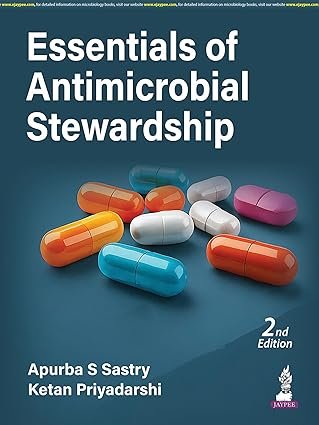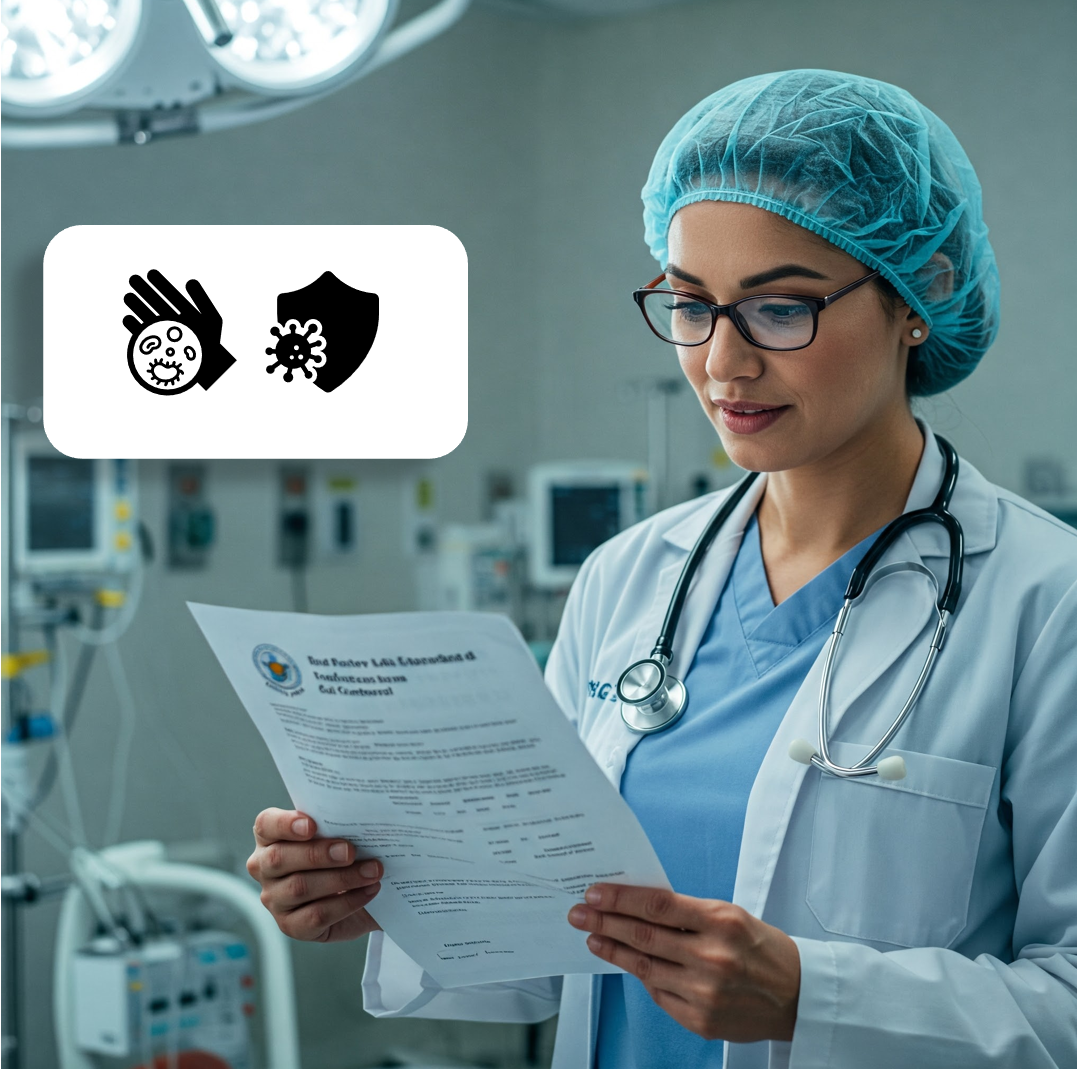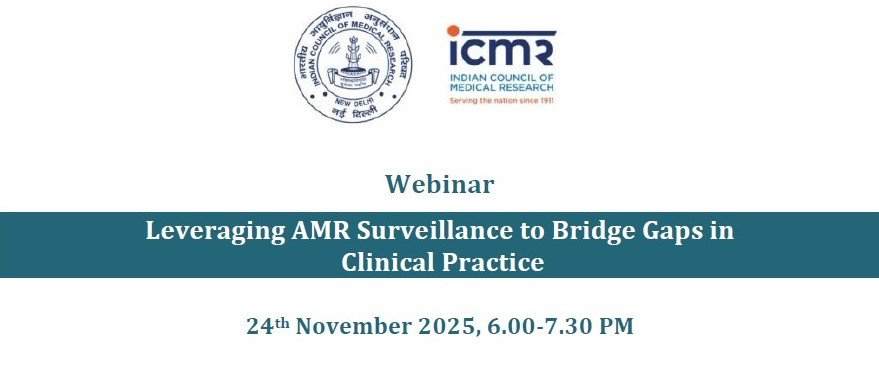Disclaimer: This post is for academic purposes only. Please read the original document if you intend to use them for clinical purposes.
This document summarizes the “Technical Guidelines for Surveillance and Reporting of Healthcare Associated Infections (HAI) at District Level Health Facilities” in India published in 2025 by National Health Systems and Resource Centre (NHSRC), Ministry of Health & Family Welfare (MOHFW), Government of India (GOI). Its primary purpose is to standardize HAI surveillance and reporting across district-level healthcare facilities, addressing the critical public health threat of Antimicrobial Resistance (AMR). The guidelines provide country-specific definitions and methods for identifying and reporting key HAIs, including Surgical Site Infections (SSI), Caesarean Section SSI (CS-SSI), Blood Stream Infections (BSI), Urinary Tract Infections (UTI), and Ventilator Associated Pneumonia (VAP). This initiative aims to strengthen Infection Prevention and Control (IPC) programs, contribute to a national HAI repository, and inform policy formation and national action plans for IPC and AMR containment.
Themes:
A. The Growing HAIs and AMR:
- Definition of HAIs: HAIs are infections acquired by patients during healthcare delivery, not present or incubating at admission, and typically manifest after two days of admission. They can be caused by various microorganisms (bacteria, viruses, fungi, parasites).
- Common Types of HAIs: The most common types include Bloodstream Infection (BSI), Urinary Tract Infection (UTI), Pneumonia {including Ventilator Associated Pneumonia (VAP)}, Surgical Site Infection (SSI), and gastro-intestinal infection.
- Global Burden: HAIs are a significant public health threat, impacting morbidity, mortality, and quality of life. The WHO’s “Global Report on IPC“ of 2022 estimated that 7 in High-income countries and 15 in Low- and Middle-income countries (LMICs) acquired at least one HAI among 100 acute care hospital patients, with one in every 10 affected patients dies from these infections.
- Economic Burden: HAIs impose a substantial economic burden due to prolonged hospital stays, long-term disability, and increasing antimicrobial resistance.
- AMR Crisis: AMR is a central public health concern, particularly in India, exacerbated by relatively weak regulatory oversight in pharmaceutical retailing, rampant over-prescription of antimicrobials by doctors, and a lack of awareness among the general population. Healthcare services are identified as the “most significant contributor.“
- Evidence of AMR in India: A 2023 survey by the National Centre for Disease Control (NCDC) across 20 major hospitals found that 72% of patients surveyed were prescribed antibiotics, and 4.6% of patients took four or more types of antibiotics.
- National Response to AMR: The Ministry of Health and Family Welfare (MOHFW) has a national AMR containment program, with NCDC as the nodal institution, establishing the National Antimicrobial Surveillance Network (NARS-Net). A key component is “the development and implementation of a coordinated system for HAI surveillance and reporting at the health facility level.“
B. Purpose and Scope of the Guidelines
- Standardization: The document aims to provide evidence-based, country-specific definitions and formats for identifying and reporting HAIs in district-level healthcare facilities, aligning with international standards (ECDC, CDC) and adapted for the Indian context by NCDC, ICMR, and AIIMS, New Delhi.
- Integration with Existing Programs: These guidelines align with the IPC activities outlined under the Kayakalp program and the National Quality Assurance Standards (NQAS) at the health facility level. They will help hospitals conduct HAI surveillance, report findings, and develop key performance indicators (KPIs).
- Resource Efficiency: District Level Hospitals can implement these guidelines without requiring a separate specialised organisational structure or additional resources, utilizing existing frameworks like the Hospital Infection Control (HIC) Committee and Quality Team.
- National Impact: At national and health system levels, these guidelines are expected to enhance the national effort to prevent the spread of antimicrobial resistance and develop a national repository and mapping of HAIs across the country. This data will be crucial for creating a coordinated response and guidelines to combat the emerging patterns of antimicrobial resistance, developing standard treatment guidelines, and informing policy.
- Applicability: The guidelines are designed for various district-level health facilities, including teaching hospitals, secondary care district hospitals, and women and child hospitals. It’s acknowledged that not all district hospitals can carry out surveillance activities and reporting for every type of HAI, and they should selectively adopt these practices according to their service scope and capabilities.
C. Organizational Structure and Roles for HAI Surveillance
- Need for Standardization: Current HAI surveillance at health facilities do not adhere to a standardised methodology or pattern, leading to a lack of national benchmarks and trend analysis. These guidelines address this by standardizing the process.
- Framework: The organizational structure for HAI surveillance and reporting will mirror existing quality improvement structures
- National Level, i.e. NHSRC: Develops guidelines, coordinates with national stakeholders (MOHFW, ICMR, NCDC, AIIMS), supports states, coordinates national online reporting, analyzes and publishes data, and ensures monitoring and evaluation.
- State Quality Assurance Unit: Organizes dissemination, develops state-specific SOPs, reviews findings and trends, creates expert groups, and coordinates with NHSRC for national reporting.
- District Quality Assurance Unit: Coordinates and monitors implementation at district-level health facilities, and arranges training.
- District Hospital Quality Team: Leads implementation, ensures staff training, provides resources for surveillance and microbiology testing, and conducts monthly reviews, maintaining HAI-related KPIs within Kayakalp and NQAS.
- Roles & Responsibilities:
- Surveillance Coordinator: Oversees HAI surveillance, ideally a microbiologist, pathologist, or general medicine specialist/surgeon. Responsibilities include ensuring regular reporting, reconciling data, disseminating reports, and facilitating data-driven IPC activities.
- Surveillance Staff: Ideally Infection Control Nurses (ICNs) stength recommended is at one full-time dedicated ICN per 250 beds to conduct day-to-day activities like case finding, data collection, case determination, and recording. They evaluate patient data sources (medical records, lab results, clinical team discussions) and conduct environmental surveillance.
- Clinical Staff (ICU/NICU/SNCU/Wards): Must be aware of ongoing surveillance, familiar with case definitions to assist in identifying potential cases, promote a blame-free reporting culture, and may collect denominator data.
D. Essential Elements of HAI Surveillance
- Active, Patient-Based, Prospective: The surveillance process requires active, patient-based, prospective identification of cases and collection of denominator data by staff trained in this HAI surveillance protocol.
- Key Stages:
- Planning: Determine responsibilities, establish goals, follow national guidelines, select applicable HAIs, use case definitions, and promote collaboration.
- Data Collection: Follow standardized protocols, identify responsibilities, identify data sources, ensure data quality, maintain a facility-level database, and train staff.
- Analysis: Analyze data regularly (monthly, quarterly, yearly), focus on KPIs, and use simple tools.
- Interpretation: Contextualize data, monitor trends, explore etiologies, benchmark against other facilities, and interpret for continuous IPC improvement.
- Communication/Feedback: Identify stakeholders, develop reports, engage in discussions, share with DQAU/SQAU, provide tailored feedback, and incorporate findings into training.
- Monitoring and Evaluation: Implement periodic reviews, assess adherence, evaluate impact on HAI reduction, share results, and utilize findings for continuous improvement.
- Surveillance Settings: In-Patient Care Wards, Adult and Neonatal ICU, Special Neonatal Care Unit (SNCU), Maternity and Post-Natal Care Units, Post Surgical Wards.
- Surveillance Events (Modules): SSI, CS-SSI, BSI (including CLABSI), UTI (including CAUTI), VAP. Case definitions are for surveillance only, not clinical diagnosis/treatment.
E. Establishing Linkages with Clinical Laboratories
- Critical Role: Microbiology laboratories are “essential” for surveillance.
- Challenges: District Hospitals often lack in-house microbiological testing.
- Solutions:
- Hospital’s Own Clinical Laboratory: Ideal, with close communication with surveillance teams.
- Integrated Public Health Laboratory (IPHL): Newly established at the district level through Ayushman Bharat Health Infrastructure Mission, providing comprehensive lab services.
- Referral Laboratory at Medical Colleges: Government teaching hospitals serve as referral labs.
- Outsourced Clinical Laboratories: Private sector hub-and-spoke models providing online reporting.
- Support: Hospital management must ensure these linkages are established, with financial resources potentially from RKS funds or quality improvement incentives (NQAS/Kayakalp).
F. Specific HAI Surveillance Protocols (Overview)
1. Surgical Site Infections (SSI)
- Settings: General and Maternity Operation Theatres, post-surgical inpatient wards.
- Event Criteria: At least one incision through skin/mucous membrane, or reoperation, occurring in an operating room (OR, C-section room, procedure areas). ASA score 6 procedures are excluded.
- Monitoring: Active, patient-centered prospective surveillance, including in-hospital and post-discharge methods (medical record review, lab reports, ward visits, follow-ups by phone/mail).
- Definitions: Date of Event (first criterion met), Wound Classification (Clean, Clean-Contaminated, Contaminated, Dirty/Infected).
- SSI Criteria: Defined for Superficial incisional (within 30 days, skin/subcutaneous tissue), Deep incisional (within 30 or 90 days, deep soft tissues like fascia/muscle), and Organ/Space SSI (within 30 or 90 days, deeper than fascia/muscle layers). Each has specific signs, symptoms, and diagnostic evidence (purulent drainage, identified organisms, deliberate opening, abscess, imaging).
- Surveillance Periods: Superficial incisional SSIs followed for 30 days; deep incisional and organ/space for 30 or 90 days.
- Data Collection: Numerator (SSI case report form including patient demographics, procedure details, SSI criteria, pathogens, antibiotic susceptibilities, outcome) and Denominator (Procedure form for all relevant surgeries, excluding patients who expire in the OR).
- Data Analysis: SSI rates calculated as (No. of SSIs / Total surgeries in that category) X 100.
2. Caesarean Section Surgical Site Infections (CS-SSI)
- Focus: Sustainable and feasible post-C-section SSI surveillance for Lower Segment Caesarean Sections (LSCS).
- Settings: All District Hospitals performing C-sections. May extend to Sub-Divisional Hospitals and Community Health Centres .
- Key Terms: Surveillance Period, Surveillance Inpatient Period, Post-discharge Period, Follow-up Period (30 days), Elective/Emergent Procedure, Wound Class, Diagnosed Wound Infection.
- SSI Case Definition: Within 30 days post-procedure, with purulent discharge OR reopening of wound OR fever with painful, spreading erythema. Laboratory culture results can aid clinical diagnosis but are not included in this surveillance protocol.
- Surveillance Methods:
- Infection Control Assessment: Baseline and annual assessments of focused IPC practices (hand hygiene, pre-surgical prophylaxis, sterilization, aseptic practices, environmental cleaning) in labor rooms, OTs, and post-surgical wards.
- Surveillance Population: All patients undergoing C-sections, tracked via a Surgical Safety Checklist and Surveillance Form.
- Case Finding:
- First wound assessment around post-operative Day-3.
- Second wound assessment at discharge (final if no post-discharge follow-up).
- Third wound assessment (post-discharge): Telephone interviews (around day 30), follow-up clinic visits, or during suture removal/wound assessment if patient returns. 3 attempts for phone contact are recommended before marking “lost to follow-up.”
- Denominator Data: Total number of C-sections performed monthly, categorized by elective or emergent.
- Case Reporting: Via the Surgical Safety Checklist and Surveillance Form.
- Analysis Plan: Total SSI rate, Elective SSI rate, and Emergent SSI rate (all per 100 procedures).
3. Blood Stream Infections (BSI)
- Settings: Intensive care units (Adult ICUs, Sick Newborn Care Units – SNCU), due to high device utilization and ease of data collection.
- Key Terms: Recognized Pathogen (e.g., S. aureus, E. coli), Common Commensal (e.g., Staphylococcus epidermidis, Streptococcus viridians – often “contaminant” but can cause true BSI, especially with multiple cultures/healthcare exposure).
- BSI Surveillance Definitions:
- Recognized Pathogens: One or more positive blood cultures.
- Common Commensals: ≥2 matching positive blood cultures AND at least one sign/symptom (fever/hypotension for >12 months; fever/hypotension/hypothermia/apnoea/bradycardia for ≤12 months). Rules for two matching cultures are detailed (different sites for simultaneous samples, separate draws/disinfection for same site, or consecutive days for different times).
- Additional Definitions: Primary BSI (originating in bloodstream), Central line-associated BSI (CLABSI – primary BSI with temporary central line >2 calendar days, or removed day before/of event, terminating in great vessels or near heart), Secondary BSI (matching positive culture from another body site within 14 days before to 7 days after BSI event date).
- Surveillance Methods: Active, patient-based, prospective case identification and denominator data collection.
- Case Finding Flowchart: Detailed algorithm starting from positive blood culture, organism type, matching cultures, symptom criteria, and inclusion/exclusion rules (e.g., Date of Event >2 days after hospital/unit admission, not within a previous BSI Event Timeframe).
- Case Reporting: BSI case report form, including organism and antibiotic susceptibility. Specific rules for matching common commensals (single criterion from first culture date if consecutive days), and excluding catheter tip cultures for diagnosis.
- Denominators: Central line days and patient days (collected daily). NICUs can stratify patient days by birth weight.
- Analysis Plan: Incidence rates for Total BSI, Primary BSI (per 1,000 patient days), and CLABSI (per 1,000 central line days). Device Utilization Ratio (DUR) is calculated as # of central line days / # of patient days to contextualize rates.
4. Urinary Tract Infections (UTI)
- Settings: Intensive care units (Adult ICUs, SNCU) due to high device utilization.
- UTI Surveillance Definitions: Culture-Confirmed UTI: Positive urine culture (≤2 species, ≥10^5 CFU/ml of at least one organism) AND at least one sign/symptom with no other recognized cause (fever, suprapubic tenderness, urgency, frequency, dysuria). Non-culture-confirmed UTIs are excluded.
- Additional Definitions: Indwelling Urinary Catheter (Foley catheter, excluding condom/straight in-and-out, nephrostomy, suprapubic unless Foley is present). Catheter-associated UTI (CAUTI): UTI meeting case definition AND indwelling urinary catheter >2 calendar days (or removed day before/of event).
- Surveillance Methods: Active, patient-based, prospective case identification and denominator data collection.
- Case Finding Flowchart: Algorithm for identifying UTIs, including criteria on urine culture, symptoms, and device association.
- Case Reporting: UTI case report form including organism and antibiotic susceptibility. Specific rules for contaminated cultures (>2 organisms from a single culture are excluded), but multiple cultures with >2 organisms can be used. All isolated organisms, including Candida species, should be reported.
- Denominators: Urinary catheter days and patient days (collected daily). NICUs can stratify by birth weight.
- Analysis Plan: UTI-incidence rate (per 1,000 patient days) and CAUTI rate (per 1,000 urinary catheter-days). Device Utilization Ratio (DUR) calculated as # of indwelling urinary catheter days / # of patient days.
5. Ventilator Associated Pneumonia (VAP)
- Settings: Adult Intensive Care Units (ICUs) and only for ventilated patients.
- Key Terms:
- Window Period (7 days around first criterion),
- Date of Event (first criterion met, lab specimen collection date if applicable),
- Healthcare-associated Infection (HAI – Date of Event >2 days after hospital admission),
- Present on Admission (POA – Date of Event ≤2 days after hospital admission; excluded from surveillance).
- Event Timeframe (14 days after Date of Event, during which no new infections of the same primary HAI type are reported for that patient; additional organisms are added to the existing event).
- Ventilator (any device supporting respiration via artificial airway for >2 calendar days, or removed day before/of event).
- VAP Surveillance Definitions (Diagnostic Algorithm): Requires at least one of each component (A+B1+B2+C = VAP):
- A. Chest Imaging: New/persistent or progressive/persistent infiltrate, consolidation, or cavitation.
- B. Signs and Symptoms:
- B.1 (Fever, Leukopenia/Leukocytosis, altered mental status for adults ≥70) AND
- B.2 (New/worsening purulent sputum, increased respiratory secretions/suctioning, new/worsening cough/dyspnea/tachypnea, rales/bronchial breath sounds, worsening gas exchange).
- C. Lab Findings: Organism from blood/pleural fluid, positive quantitative/semi-quantitative culture from BAL/endotracheal aspirate, ≥5% BAL-obtained cells with intracellular bacteria on Gram’s stain, definitive diagnosis of fungal/viral/bacterial pneumonia via specific tests. For immunocompromised patients, matching Candida spp. from blood and sputum/BAL is also positive. (Excludes coagulase-negative Staphylococcus, Enterococcus, non-specified Candida species as pathogens, except for immunocompromised Candida spp.).
- Surveillance Methods: Active, patient-based, prospective identification and denominator data collection.
- Case Finding: Daily review of microbiology records, X-rays, patient charts (admission/discharge, history/physical, notes, temperature charts). Clinical staff assist in identifying potential cases. Radiologists/clinicians confirm X-ray interpretation.
- Case Reporting: VAP case report form, including organism and antibiotic susceptibility, submitted after the Event Timeframe. Cases must meet specific criteria (Date of Event >2 days from hospital/unit admission, not within previous VAP Event Timeframe).
- Denominator Data: Ventilator days and patient days (collected daily at the same time).
- Analysis Plan: VAP Rate per 1000 ventilator days = (No. of VAPs / No. of Ventilator Days) X 1000. Ventilator Utilization Ratio (DUR) = (No. of Ventilator Days / No. of Patient Days).
Important points:
- Integrated Approach to Public Health: This document highlights India’s multi-pronged strategy to combat AMR, integrating HAI surveillance into existing quality assurance programs (Kayakalp, NQAS) and leveraging national infrastructure like IPHLs and medical college referral labs.
- Standardized Definitions and Methodologies: The core strength of these guidelines lies in providing “evidence-based, country-specific definitions and formats” for HAIs, adapted from international standards, to ensure data consistency and comparability across diverse district-level facilities. This addresses a current gap in standardised methodology or pattern.
- Focus on District-Level Facilities: The emphasis on “District Level Health Facilities” signifies a crucial expansion of HAI and AMR surveillance beyond central government and tertiary care institutions, recognizing that vast majority of public health institutions at the secondary care (DH, SDH, CHC/FRU) and primary care levels need to be engaged.
- Importance of Lab Linkages: The explicit strategies for establishing “close cooperation with other public health sector clinical laboratories” acknowledge a key infrastructural challenge at district hospitals and propose practical solutions, including financial support.
- Multidisciplinary Teamwork: The outlined roles and responsibilities for Surveillance Coordinators, Surveillance Staff (ideally ICNs), and Clinical Staff (nurses and physicians) underscore the necessity of a collaborative, multidisciplinary approach to effective surveillance.
- Data-Driven IPC Improvements: The entire surveillance cycle, from planning and collection to analysis, interpretation, and communication, is designed to generate actionable insights, enabling facilities to “adjust IPC strategies” and translate data into “action points for IPC related improvements.“
- Specific HAI Modules: The detailed modules for SSI, CS-SSI, BSI, UTI, and VAP provide clear, actionable instructions, case definitions, and reporting forms, which are critical for consistent implementation. The inclusion of explicit examples (e.g., BSI case definition application) enhances clarity.
- Denominator Data for Contextualization: The consistent collection of denominator data (patient days, central line days, urinary catheter days, ventilator days) and the calculation of Device Utilization Ratios (DURs) are crucial for “contextualizing” incidence rates and understanding the true burden of device-associated infections.
- Post-Discharge Surveillance: For SSIs, particularly CS-SSIs, the inclusion of “post-discharge surveillance methods” (e.g., telephone interviews) recognizes that many infections become evident after discharge, ensuring a more comprehensive picture of HAI burden.
- Differentiation of Surveillance vs. Clinical Definitions: A key clarification is that “the case definitions used for the above events provided in this guideline are to be used for surveillance only and are not meant to serve as clinical definitions for use in diagnosis and treatment.” This ensures that surveillance data collection does not interfere with immediate patient care decisions.









